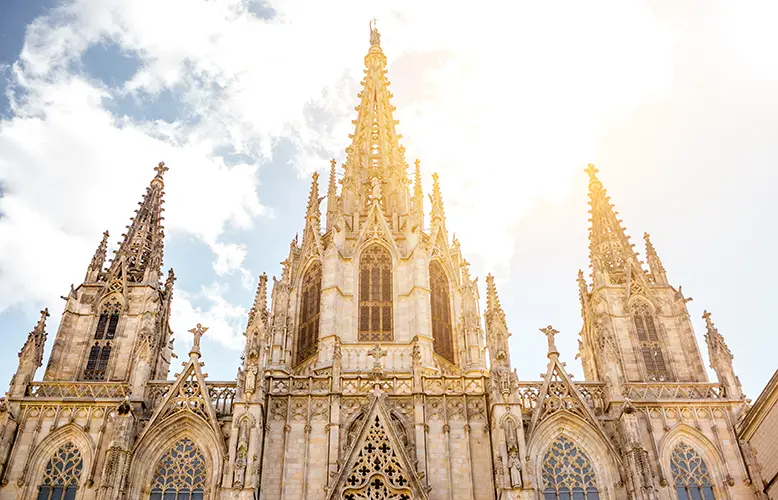Nestled within the heart of Barcelona, the Gothic Quarter stands as a living testament to the city’s rich history, architectural splendor, and vibrant culture. As sunlight filters through narrow cobblestone alleys and dances across centuries-old facades, visitors embark on a journey through time, immersing themselves in the enchanting allure of this medieval neighborhood.

In this bustling metropolis, where the modern seamlessly intertwines with the ancient, the Gothic Quarter emerges as a captivating labyrinth of narrow streets, hidden squares, and storied landmarks. Every step echoes the footsteps of generations past, whispering tales of Roman origins, medieval grandeur, and the spirited pulse of contemporary Catalan life.
Our self-guided walking tour of Barcelona invites you to unravel the layers of history etched into the very stones beneath your feet. As you meander through the labyrinthine streets, each twist and turn unveils a new chapter in Barcelona’s narrative, offering a profound and immersive exploration of one of Europe’s most cherished neighborhoods.
5 Must-Visit Places in the Gothic Quarter
The Gothic Quarter is one of Barcelona, Spain’s most enchanting and historic neighborhoods. Steeped in centuries of history, this labyrinthine area is a treasure trove of medieval architecture, narrow alleys, and charming squares. Here are five must-visit places in the Gothic Quarter.
Plaça Nova and the Cathedral
At the heart of the Gothic Quarter lies Plaça Nova, a bustling square surrounded by historic buildings. The standout feature of this square is the Barcelona Cathedral, also known as the Cathedral of the Holy Cross and Saint Eulalia. The cathedral dates back to the 13th century and is a stunning example of Catalan Gothic architecture. Visitors can explore the interior, including the abbey and the rooftop, for panoramic city views.
Visitors are transported through the cathedral’s doors into a world of religious grandeur and architectural splendor. The interior has soaring columns, rib vaulted ceilings, and a sense of sacred serenity. The abbey, an oasis of tranquility within the bustling Gothic Quarter, features a charming courtyard inhabited by thirteen geese, symbolizing the age of Saint Eulalia, the patron saint of Barcelona.
One of the highlights for those with a penchant for heights is the ascent to the cathedral’s rooftop. Climbing the narrow spiral staircase rewards visitors with panoramic views of Barcelona’s skyline, providing a unique perspective on the city’s architectural evolution from medieval to modern times. The spires and gargoyles create a silhouette against the sky, emphasizing the cathedral’s religious and architectural landmark role.
Plaça de Sant Josep Oriol and Plaça del Pi
These adjacent squares offer a charming blend of history and local life. Plaça de Sant Josep Oriol is dominated by the Church of Sant Josep Oriol, known for its beautiful Baroque facade. The square is a lively gathering spot with outdoor cafes and street performers. Just a short walk away, Plaça del Pi is home to the Basilica de Santa Maria del Pi, a Gothic church with a stunning rose window. The squares are perfect for strolls and soaking in the vibrant atmosphere.
Centered around the imposing Church of Sant Josep Oriol, this square exudes a lively yet relaxed atmosphere. The church, with its Baroque facade adorned with sculptures and decorative elements, serves as both a religious focal point and a captivating architectural backdrop. The square is a meeting place for locals and visitors alike, with outdoor cafes spilling onto the cobblestone pavement. It’s a place to savor a cup of coffee, observe street performers, and soak in the vibrant energy of Barcelona.
Plaça de Sant Felip Neri
Tucked away in a quieter corner of the Gothic Quarter, Plaça de Sant Felip Neri is a hidden gem with a poignant history. The square is surrounded by the Church of Sant Felip Neri, scarred by shrapnel from bombings during the Spanish Civil War. The serene ambiance of the square, combined with its tragic past, creates a moving experience for visitors.
This intimate square bears witness to a tragic chapter in Barcelona’s history, as evidenced by the scars that still mark its surroundings. The square’s centerpiece is the Church of Sant Felip Neri, a modest yet beautiful Baroque structure. However, the gravestones embedded in its walls and the pockmarked facades of nearby buildings tell a somber tale. During the Spanish Civil War, in 1938, the square became the unintended target of a bombing raid, resulting in the loss of numerous lives, many of them children from a nearby school.
Plaça del Rei
Plaça del Rei, or King’s Square, is a historic square that transports visitors back to medieval Barcelona. The square exudes a sense of regality, surrounded by impressive buildings, including the Palau Reial Major (Grand Royal Palace) and the Chapel of St. Agatha. The Museu d’Història de Barcelona (Barcelona City History Museum) is located here, offering a journey through the city’s past with archaeological finds and exhibits.
A collection of notable structures frames Plaça del Rei, each contributing to the square’s unique charm. The Palau Reial Major (Grand Royal Palace) dominates the scene with its regal facade. This palace served as the residence of the Counts of Barcelona and later the Kings of Aragon. The Saló del Tinell, an impressive Gothic hall within the palace, has witnessed significant historical events, including the Catholic Monarchs’ reception of Christopher Columbus upon his return from the Americas.
Plaça de Sant Jaume
This square is the political and administrative heart of Barcelona. Bordered by the City Hall (Ajuntament) and the Palau de la Generalitat de Catalunya (Palace of the Generalitat of Catalonia), Plaça de Sant Jaume is a significant civic space. It has been the site of political and social gatherings throughout history. The architecture surrounding the square is noteworthy, and the atmosphere is vibrant, especially during public events and celebrations.
Exploring these five places in the Gothic Quarter provides a rich tapestry of Barcelona’s history, culture, and architecture, making it a must-visit destination for travelers and history enthusiasts alike.





